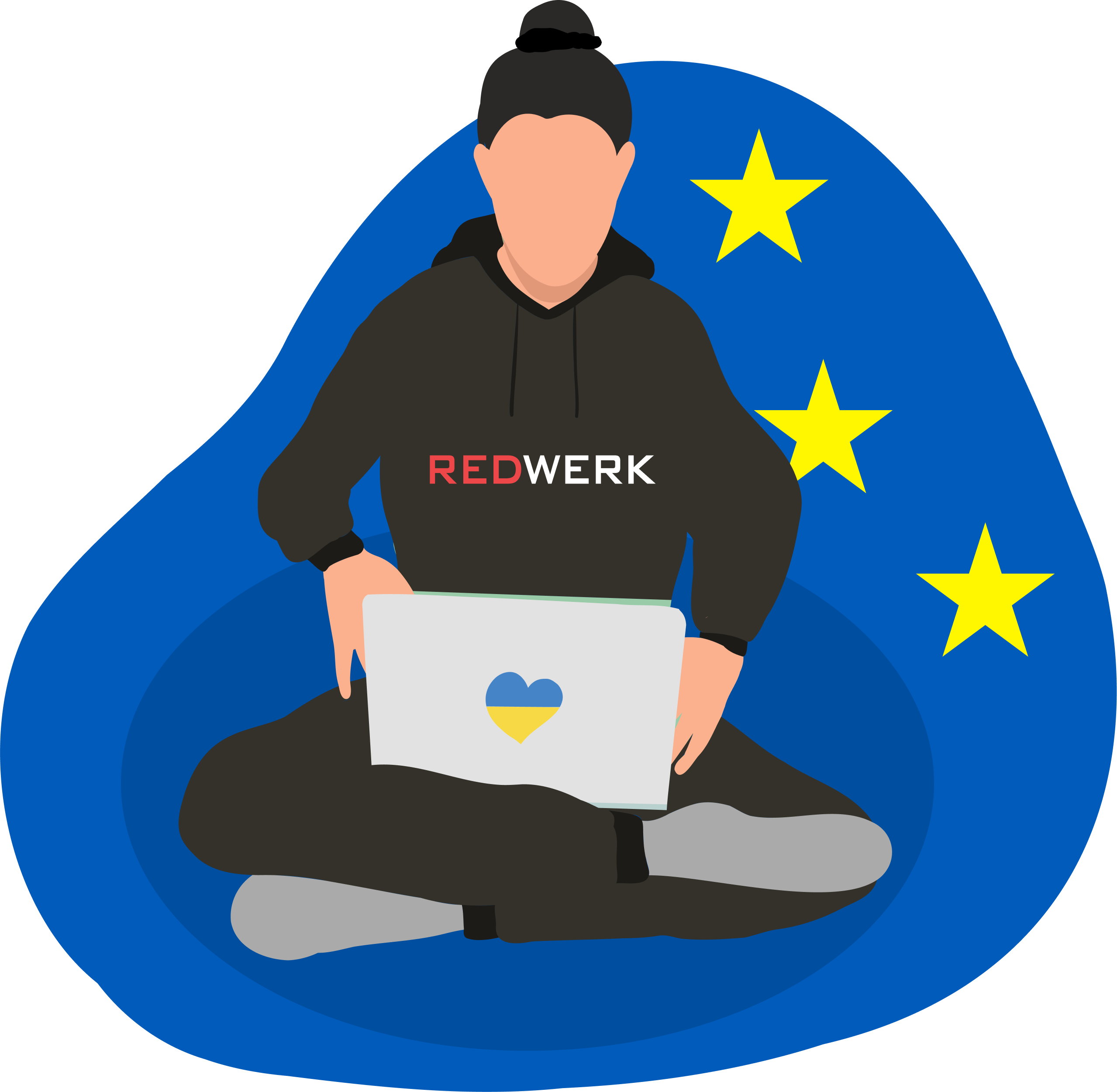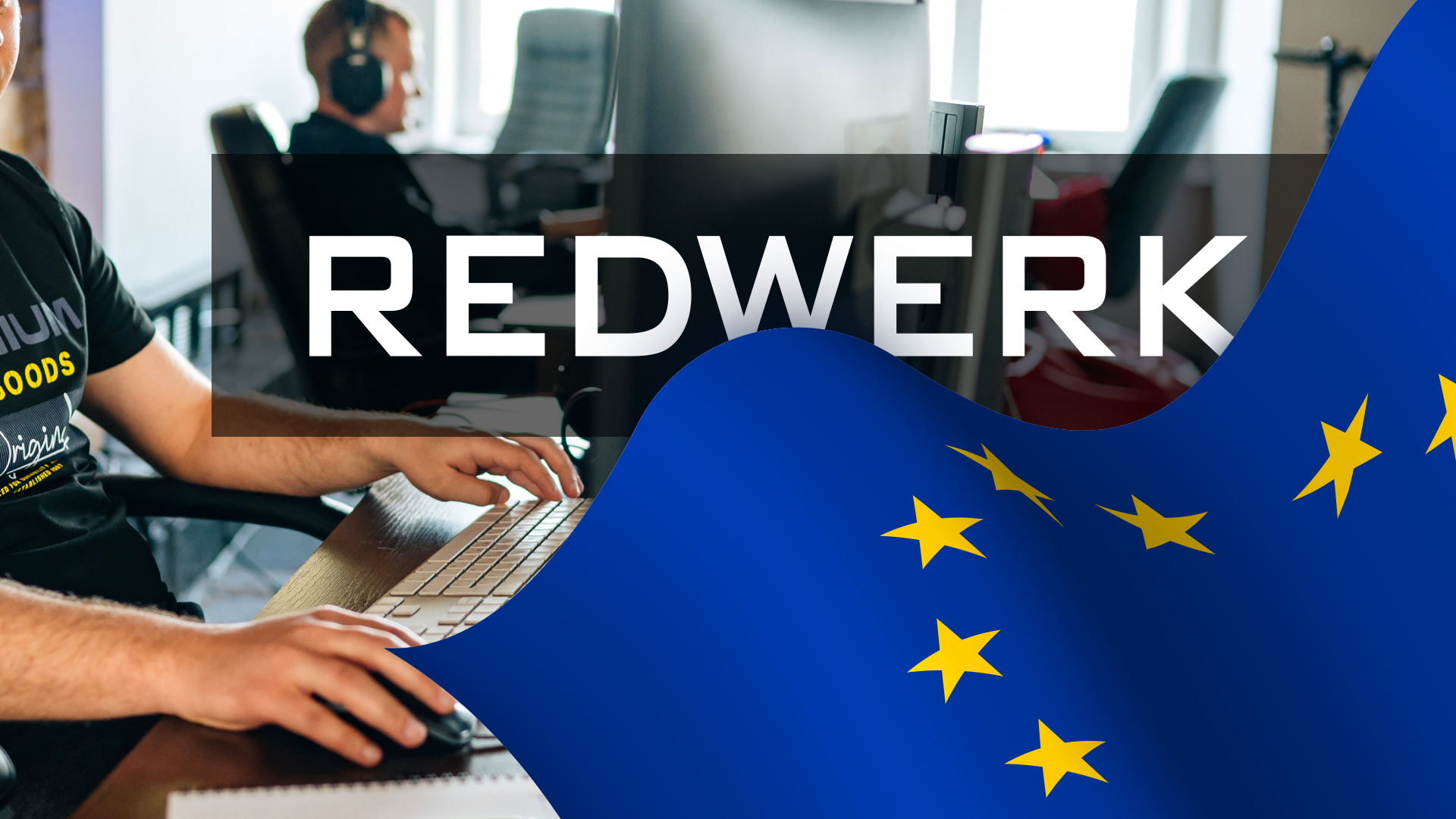Ukraine has recently been granted EU candidate status, and it’s a huge step forward on our turbulent path of European integration. A truly historic moment and a clear message to the Kremlin that Ukraine is a free, democratic state stepping into the future and leaving imperialistic Russia behind.Why is this important for Redwerk? First, we’re a Ukraine-based company. We stay in Ukraine, continue working and hiring from Ukraine, and do our best to support our people and the military.
Second, as a software development agency, we were hired to extend and upgrade the EU Parliament e-voting solution. The same platform that the EU Parliament officials used to vote for recognizing Ukraine as an EU candidate. That makes us incredibly proud and proves that although we have a ton of reforms underway, Ukraine is already very advanced IT-wise.
Before we jump into the software development part, we’d like to break down Ukraine’s entire journey to becoming an EU candidate. Did Ukraine have preferential treatment because of the war, or was it a well-deserved achievement?
In this article, we’ll cover:
Ukraine Is Now EU Candidate
On June 23, the EU Parliament officials met at the summit in Brussels to discuss the EU Commission’s recommendation to grant Ukraine candidate status.
Out of 588 votes, 529 were in support of Ukraine. However, the resolution also had to be unanimously supported by the European Council. All 27 member states of the EU voted for Ukraine to become a candidate for EU membership.
Sincerely commend EU leaders’ decision at #EUCO to grant 🇺🇦 a candidate status. It’s a unique and historical moment in 🇺🇦-🇪🇺 relations. Grateful to @CharlesMichel, @vonderleyen and EU leaders for support. Ukraine’s future is within the EU. #EmbraceUkraine https://t.co/o6dJVmTQrn
— Володимир Зеленський (@ZelenskyyUa) June 23, 2022
President Volodymyr Zelenskyy submitted the EU candidate application days after Russia invaded Ukraine. There probably hasn’t been a day when he didn’t appeal to parliaments worldwide, asking for support and reasoning why Ukraine belongs to the EU. He spoke with the United Nations, British Parliament, U.S. Congress, at the Cannes Film Festival, America’s Grammy Awards, and held a news conference right from Kyiv’s subway.
Four months later, we received what we as a nation have aspired to from the early years of our independence. It’s only at first glance that the process seems fast-tracked. Let’s rewind a bit and see how much work and how many sacrifices we’ve made to be where we’re at right now.
Ukraine’s Path to EU
Ukraine’s European integration journey has never been easy. The first talks about Ukraine moving toward a European perspective go back to the mid-nineties. In 1994, Ukraine signed a Partnership and Cooperation Agreement with the EU, which emphasized the importance of a market economy and democratic values. It set the ground for establishing a free trade area in the future.
Association Agreement
At the Ukraine-EU summit in 2008, both parties agreed they were ready to sign a more ambitious agreement to deepen our relations in all areas. It was called the Association Agreement, and it was designed to “strengthen political association and economic integration between Ukraine and the European Union by means of reciprocal rights and obligations.”
In simple terms, this agreement outlined a range of principles for regulatory approximation of Ukraine to EU standards, which would help Ukraine gradually integrate into the EU internal market. After that, there were dozens of negotiation rounds stretched across the years.
Finally, in 2013, Ukraine was about to sign the Association Agreement at the Eastern Partnership Summit in Vilnius. However, the then-ruling President Yanukovych suddenly changed the course of direction and froze all preparations for signing the agreement. Instead, he offered a new, trilateral format of negotiations – Ukraine-EU-Russia, fully revealing his pro-Russian position. It was the last straw for the Ukrainian people, who were sick and tired of Putin’s puppets throwing monkey wrenches and dragging Ukraine to the bottom of its soviet past.
Euromaidan Protests
People took to the streets to rally against de-facto becoming Russia’s satellite state and demanded the immediate resignation of the pro-Kremlin government. Another condition was to pass the remaining European integration laws and sign the Association Agreement. With no prospect of change from the government, the protests grew into Euromaidan, also known as the Revolution of Dignity. It took the lives of over one hundred people. They died hoping to live in a free and democratic Ukraine, where there’s a rule of law and human rights are the highest priority.
Ousting Putin’s agents came at a price. In 2014, Russia annexed the Crimean Peninsula and occupied part of the Luhansk and Donetsk regions using political instability and the groundwork laid by Yanukovych. At the same time, the new government finally signed the Association Agreement. It took three more years to complete the ratification process.
Ukraine’s Turbulent Journey to EU Candidacy
Looking at this timeline, it is clear that Ukraine has gone through a lot to earn EU candidacy, and the process wasn’t actually accelerated. It’s a reasonable and well-deserved outcome.
| 1994 | Partnership and Cooperation Agreement with the EU |
| 1998 | First time Ukraine declared its desire to become an EU associate member |
| 2007 | Negotiations about a wider agreement and free trade area |
| 2009 | Ukraine became the EU Eastern Partnership participant |
| 2010 | First talks about visa-free travel to EU countries |
| 2012 | Ukraine and the EU initialed the Association Agreement |
| 2013 | Freeze of the Association Agreement preparations. Euromaidan |
| 2014 | Both parts of the Association Agreement were signed. Russia annexed the Crimean peninsula and occupied part of Luhansk and Donetsk regions |
| 2017 | Association Agreement ratified. Visa-free regime between the EU and Ukraine |
| 2019 | Ukraine’s course for membership in the EU and NATO enshrined in the Constitution |
| 2021 | Common Aviation Area between the EU and Ukraine |
| 2022 | Russia invaded Ukraine. Ukraine applies for EU candidacy and receives the status |
Since 2014, Ukraine has been in a state of hybrid war with Russia, trying to achieve a ceasefire and peace with limited success. Russia’s involvement in resolving the conflict was nominal. Not surprising, given it has been plotting a full-scale invasion all these years.
What It Means For Ukraine
For us Ukrainians, it’s yet another victory. Yes, we’ve suffered losses since the 24th of February; we haven’t pushed the aggressor out of our borders yet, but we already won. The entire world has woken up and saw Russia for what it really is – a terrorist state grabbing pieces of land on a whim and causing destruction and death everywhere it steps.
For over four months, we’ve been heroically standing our ground when initially, some world leaders gave us three days. Ukraine has become synonymous with bravery, resiliency, and the protector of democratic values.
The EU candidate status legally recognizes Ukraine as part of the European family and further solidifies our pro-west foreign policy direction.
I believe in Ukraine’s European future. It is your future and only you can make it happen.
You can change this country for good and this will be your ultimate victory.
A free and vibrant Ukraine.
A sovereign Ukraine, finally reunited with our European family. pic.twitter.com/HB3DvP0ykz
— Ursula von der Leyen (@vonderleyen) July 1, 2022
Even though the candidacy doesn’t confer membership, it triggers an array of positive transformations, such as:
- Higher Living Standards. Preparing for EU membership requires reforms aimed at approximating the living standards of Ukrainians to those of Europeans. Meeting the accession criteria also necessitates improvements in civil liberties, eradicating corruption, and limiting the power of oligarchs.
- IPA Funding. Countries with the EU candidate status receive guaranteed financial aid in line with the Instrument for Pre-Accession Assistance. This funding is essential given that we must rebuild our country’s infrastructure severely damaged by the aggressor.
- Foreign Investments. As Ukraine implements reforms, it becomes more attractive to foreign investors from EU member states. Just recently, Ukraine ratified the Istanbul Convention, which signifies Ukraine’s determination to transform fast and uphold core human rights.
- New Opportunities. The EU candidacy opens the door to various grants, initiatives, and programs that haven’t been available before. This translates into knowledge transfer between the EU and Ukraine and tangible benefits to individual students, scientists, artists, farmers, small and medium enterprises, and civil society at large.
The war opened the eyes not only of European leaders but also of Ukrainians who had been undecided about the pro-west orientation of Ukraine. Pre-war, the number of people supporting European integration stood at 61%. After the invasion, 91% of Ukrainians wholeheartedly wanted to see Ukraine among EU member states. People have changed and consolidated all of their efforts towards one goal – winning the war and becoming a prosperous European state.
Under the Hood of EU E-Voting System
Did you know that the software used by the EU Parliament daily was developed by Italians and further upgraded by Ukrainians?
The EU e-voting solution was initially developed and maintained by Eurel Informatica SpA, an Italian provider of e-voting, conference, and public administration solutions. With the course of time and the development of new technologies, the need to modernize it and add additional modules to improve workflows and security arose. And that’s where Redwerk comes in. Eurel partnered with us to strengthen their dev team with Java and DevOps experts and manage projects more efficiently.
Redwerk E-Government Expertise
Since 2005, the year Redwerk was founded, e-government has remained one of our primary business vectors. Among the first e-government projects we delivered was YouTown, a SaaS helping citizens connect with local governments. It was awarded Champions of Change by the White House and adopted across cities in the USA and the Netherlands.
Another successful project we delivered in partnership with Green Valley BV, this time to the Netherlands and Belgium public sector, was a citizen request management software for city councils. We developed the product from the ground up, factoring in EU e-government regulations. The solution was used by 50% of city councils in the Netherlands and Belgium.
Later, we also built a custom module for the Maasmechelen municipality, Belgium, which relied on Green Valley’s e-government CMS. We added an option to make online listings or reservations for events. This module was profile-aware, meaning it was available both on the intranet for public servants and the internet for regular citizens.
As of our most recent projects, we helped Change & Innovation Agency mirror their public sector consulting expertise in Current™, a service delivery SaaS for health and human services agencies. We developed the entire solution from the ground up, ensuring it’s 100% ADA compliant. Current™ is adopted by ten state and county human services agencies across the USA, while many more agency implementations are on the horizon.
Last but certainly not least is our contribution to developing, upgrading, and deploying the code running under the hood of the EU Parliament e-voting system. Let’s dive deeper into that.
The Challenge
Our primary task was to develop a small module enabling authorized access to the voting results of various EU Parliament committees. The services we were to deliver aimed at simplifying the data retrieval process while ensuring security through authentication and granular permissions.
While developing the solution, we faced several challenges.
Proprietary System. Working with a proprietary system means dealing with some legacy elements and outdated libraries. The EU e-voting platform contained custom-written integration with Active Directory. For security reasons, most of the system’s components were unavailable for remote debugging. We needed to be on-site to access the documentation and work with the software, so we traveled to Brussels several times.
Tech Stack Restrictions. Given that we were integrating a new module into a broader system, we were required to stick to specific, often dated versions of Java and Python languages and libraries. It was necessary to ensure our code won’t disrupt their existing environment.
Bureaucracy. This one was expected and natural, considering the high rank of the organization we worked for. Communicating, receiving access, and agreeing on things were hindered by numerous mandatory procedures and approval rounds, which slowed down our progress.
Despite the challenges above, we complied with all the requirements specifications and handed over deployment-ready code on time.
The Solution
Our project was divided into two distinctive parts – an API for accessing the database and an API for authenticating users and communicating with the first API via a VPN channel. This two-track approach may seem redundant; however, it was done deliberately to warrant voting results’ protection.
We created an API service responding to users’ queries on the database side. We replicated the system database on our servers to perform comprehensive API debugging remotely.
The second service was responsible for user authentication and was available only within the EU Parliament’s intranet. Upon interaction with the user, the service checks if they’re authenticated, their query, and if they have respective permissions to make such queries. The service sends the request to the first API and returns the relevant data if everything is valid.
Because of proprietary code and security restrictions, we couldn’t fully replicate the production environment for development, so we split our code into chunks and fine-tuned it over three phases:
- Testing the API on the side of the database separately from the authentication service
- Testing the API with mock authentication
- Testing our module already integrated into the EU system on-site
Throughout the project, our code was scrutinized by representatives of the EU IT department, and the positive feedback we received is yet another testimony to the high quality of our solutions.
Other EU Projects
The case above is just a tiny fraction of what Eurel Informatica SpA and Redwerk have done together for the EU Parliament.
We continued working on upgrades for the e-voting platform. We added the UI and integration with two other apps to simplify the processing of voting results.
When Covid broke out, the need for a new system that would allow remote access to the assembly halls arose. So a brand-new solution was developed from scratch, and our part lay in taking care of DevOps.
Redwerk DevOps experts contributed to devising the system architecture, paying particular attention to the app load and the EU security system. We helped select the right servers, set server parameters, and install the needed packages, among other configurations.
As for DevOps, our primary goal was to automate code delivery to the server and achieve seamless deployment of the app updates. Streamlining CI/CD processes was challenging, given that the system server was hidden behind several intermediary servers for security reasons, but we did it.
Work With Ukraine
Ukraine’s EU candidacy is a rightfully earned victory and a clear sign to the Kremlin that we have allies and the light will always overcome the darkness. It’s the needed confidence and morale boost for the military fighting off the occupiers and businesses continuing to operate no matter what.
Over 4 months of the war, tech companies in Ukraine have consistently delivered quality solutions and worked at the maximum capacity to be able to pay taxes, hire the unemployed, donate, and keep the economy rolling. Doing all these is easier when you know you’re sweating for a reason, for a free, democratic, and European Ukraine!
Redwerk’s contribution to the EU Parliament software is an eloquent example of the high expertise of IT services agencies here in Ukraine. Working with Ukraine is the best and most tangible way to support us and help us win. Even if you’re all set up, refer a partner or a friend to a Ukrainian agency that you discovered or that directly reached out to you. Spreading the word costs you nothing but goes a long way in keeping Ukrainian businesses and communities reliant on them afloat.
If you’d like to learn even more about our EU Parliament project, the tech stack, and see testimonials, make sure to request a case study below.
Stand With Ukraine By Working With Ukraine!
See how we upgraded e-voting platform for EU Parliament in less than 1 month





